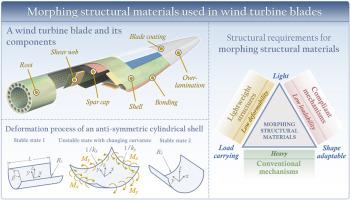用于风力涡轮机叶片的变形结构材料
IF 16.3
1区 工程技术
Q1 ENERGY & FUELS
引用次数: 0
摘要
随着人们对更清洁、更可持续能源的需求日益增长,风能产业得到了迅速发展。这一趋势导致了风力涡轮机尺寸的增加,这可能会带来诸如压力增加、控制系统更复杂、制造和运输成本更高等缺点。由于其气动效率高,重量轻,结构简单,变形结构已成为可再生能源工业的极大兴趣。变形结构是一种结构系统,能够在两种或两种以上的稳定结构中改变其几何形状,以实现目标工程功能。尽管具有许多有利的特性,但在设计变形结构方面存在重大挑战;也就是说,结构必须是柔性的,以要求低的作动力,而刚性的承载目的。解决这一问题的一种方法是使用具有各向异性或双稳态/多稳态特性的复合材料。通过对近期文献的广泛回顾,本研究旨在深入了解变形结构材料的潜在结构概念和力学性能,以及它们在风力涡轮机叶片应用中的可行性和可持续性。本文章由计算机程序翻译,如有差异,请以英文原文为准。

Morphing structural materials used in wind turbine blades
With growing demands for cleaner and more sustainable energy, there has been rapid development in the wind energy industry. This trend has led to an increase in the size of wind turbines, which could cause drawbacks such as increased stresses, more complex control systems, and more costly manufacturing and transportation. Due to their high aerodynamic efficiency, light weight, and structural simplicity, morphing structures have become of great interest in the renewable energy industry. Morphing structures are structural systems capable of shifting their geometric form across two or more stable configurations to achieve targeted engineering functionalities. Despite having many advantageous characteristics, there is a significant challenge with designing morphing structures; that is, the structure must be compliant to demand low actuation force, while being stiff for load-carrying purposes. One approach to addressing this issue is using composite materials with anisotropic properties or bistable/multistable behavior. Through an extensive review of the recent literature, this study aims to provide insights into the underlying structural concepts and mechanical properties of morphing structural materials and their viability and sustainability for wind turbine blade applications.
求助全文
通过发布文献求助,成功后即可免费获取论文全文。
去求助
来源期刊

Renewable and Sustainable Energy Reviews
工程技术-能源与燃料
CiteScore
31.20
自引率
5.70%
发文量
1055
审稿时长
62 days
期刊介绍:
The mission of Renewable and Sustainable Energy Reviews is to disseminate the most compelling and pertinent critical insights in renewable and sustainable energy, fostering collaboration among the research community, private sector, and policy and decision makers. The journal aims to exchange challenges, solutions, innovative concepts, and technologies, contributing to sustainable development, the transition to a low-carbon future, and the attainment of emissions targets outlined by the United Nations Framework Convention on Climate Change.
Renewable and Sustainable Energy Reviews publishes a diverse range of content, including review papers, original research, case studies, and analyses of new technologies, all featuring a substantial review component such as critique, comparison, or analysis. Introducing a distinctive paper type, Expert Insights, the journal presents commissioned mini-reviews authored by field leaders, addressing topics of significant interest. Case studies undergo consideration only if they showcase the work's applicability to other regions or contribute valuable insights to the broader field of renewable and sustainable energy. Notably, a bibliographic or literature review lacking critical analysis is deemed unsuitable for publication.
 求助内容:
求助内容: 应助结果提醒方式:
应助结果提醒方式:


